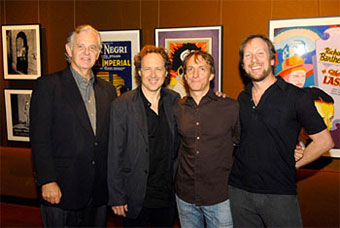

  |
|
|
||||||||||||||||||||||
|
FMS FEATURE... October 8, 2007 The Academy's "Music Soundtrack" Series Continues Broughton leads panel of contemporary film composers by Jon Burlingame  Photo by Greg Harbaugh / Copyright A.M.P.A.S. Music-branch governor and Oscar-nominated composer Bruce Broughton (Silverado) moderated the three-and-a-half-hour forum, which focused largely on the sometimes offbeat musical approaches taken by the guests. Clips of Danna's work, for example, included The Ice Storm (1997), an Ang Lee film set in 1970s Connecticut that used a Javanese gamelan. Danna said he wanted music that suggested nature and had energy, "making you look at this picture in a different way." The Sweet Hereafter (also 1997), Atom Egoyan's film about the impact of a tragic schoolbus accident on a Canadian town, used both a Persian ney flute and an early-music group featuring medieval instruments. Because the story suggested something of a Pied Piper story, Danna said he "decided to score the fable, not the action." Recording unusual instruments can be "tricky and very dangerous," Danna said, explaining that unconventional scores offer alternative approachs to dramatic problem-solving. Isham chose clips from the 2005 Best Picture Oscar winner Crash, scored for vocal and electronics, and from Afterglow (1997), a jazz score for Isham and just six other performers. In the case of Crash, Isham said, the idea was for the score to "sit above the movie," almost like "an angel" to help the filmgoer experience the film. Much of it was ambient in nature, he said, and apart from the vocalist "it was all done on a G3 Macintosh in my house." Filmmaker Alan Rudolph wrote Afterglow to one of Isham's jazz albums, and wanted that feeling for the film. Isham recalled that he chose "five fundamental emotions" experienced by the three couples in the movie, wrote themes to match them and then "gave each character an instrument. We recorded those themes with those instruments" in multiple versions, he added. "We didn't even turn on the picture." Sometimes, Isham said, "one happy accident is better than 14 hours of hard thinking about something. This whole score was a series of happy accidents." Kent discussed clips from two Alexander Payne films, About Schmidt (2002) and Sideways (2004). Schmidt used the surprising sounds of an erhu, a Chinese violin, and Tuvan voices. "Those colors had a lot of life to them," and helped to depict the "major cultural shift" undergone by Jack Nicholson's character from Omaha to Denver. Payne wanted a jazz score for Sideways, Kent noted, and organized several recording sessions that continued throughout the editing of the film, often "experimenting" and improvising as they went along. "Because we're artists," Kent said, "we do want to go out on a limb. There's a real intention to explore." The second half of the evening began with an impromptu jam session, with Kent on musical saw, Danna on tampura (Indian drone lute) and Isham on pocket trumpet. "We're just looking for the film to put this to," quipped Kent. The trio answered questions from the audience for over an hour. Fully half of the job of a film composer, Isham said, involves "the ability to work in a group dynamic," to collaborate with other artists. Film composers are craftsmen, he said, and "part of a greater whole." "We are part of the filmmaking team," Danna said, the job of the composer "to help the filmmaker tell his story, pull people into his film." Earning the trust of filmmakers was discussed at length, with Danna eliciting laughter from the audience when he talked about using "child psychology" on some directors. Kent said his hope is to create "soulful and connective and resonant" music and noted that the collaborative process often produces music that he "might not have written otherwise... Suddenly it's way better than I would have come up with." Kent also revealed that, in cases where there is no obvious direction for the music, he often asks directors a series of four questions about the scene under discussion: Whose point of view is indicated? What must the energy level of the music be? What is missing that music can supply? What do you want the audience to feel? The "temp track" –temporary music often placed into a film by editors before composers are able to create their own score –was a major topic. Danna referred to "chasing the temp," attempting to top the temporary music or at least match it in terms that would please the filmmakers. Isham said that he hates temp scores that consist of his own music. And Kent said "I try not to listen to temps." The evening began with a series of clips from the recent DVD of Major Dundee, allowing viewers to compare the original 1965 score by Daniele Amfitheatrof with the new, often more subtle, score written for the 2005 restoration by Christopher Caliendo. ©2007 Jon Burlingame |
Search
Past Features
Feature Archives
|